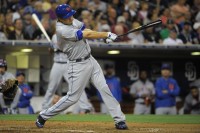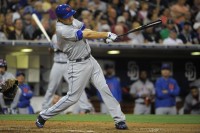Musings
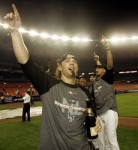
For the first time since 2008, the Mets are in a pennant race. Fans have lost their minds and started magic number counts, debating playoff rosters, and setting playoff rotations. This is a good thing, and certainly I’m not immune to it myself.
Currently, the Mets are 64-56 with a four game lead in the division. In 2008, they had the same record through 120 games and were tied for first place with the Phillies. In 2007, the Mets were 67-53 with a three game lead in the division. Long story, short, there’s nothing to celebrate yet . . . especially when those earlier Mets teams were better. Thankfully, those Phillies teams were better also.
Using straight winning percentage, the Mets are on pace for an 86-76 season. For the Nationals to tie, they would have to go 26-16 (.619). I don’t care how bad they’ve been lately; they are certainly capable of that. As I like to do at times, let’s dig a little deeper.
The Mets have 18 home games left and 24 road games left. With a home winning percentage of 66.67%, they will go 12-6 at home the rest of the way. With a road winning percentage of 38.60%, they will go 9-15 on the road the rest of the way. Adding it all up, this equates to a final record of 85-75 (not that different). Again, the Mets aren’t running away with anything.
Since August 1st, Yoenis Cespedes‘ first game with the Mets, the team has gone 11-6 (SSS Alert!), which is a fairly unsustainable winning percentage of 64.71% (over 162 games that equates to a 105-57 record). Of course, if they kept that up, they would go 27-15 the rest of the way, and the Mets will run away with the division with a 91-71 record. I can’t imagine the Nationals, no matter how talented they are, running off a 31-11 clip.
Now, it’s not really unrealistic the Mets have a terrific run to end the year. The Mets have 33 games against teams with a sub .500 record. They have gone 41-22 (.651) against those teams. There are only nine games against teams with a .500 or better record left on the schedule. This includes six against the Nationals. The Mets are 23-34 (.404) against such teams. Working the math out, the Mets will go 25-17 the rest of the way. That means the Mets will finish 89-73. This forces the Nationals to go from a .500 team to a team playing .643 ball just to tie the division.
For what it’s worth, 89-73 is how the Mets finished in 2008. They were one game worse in 2007. You know what? Those aren’t harbingers. They’re the records for completely different teams. Those Mets teams were being chased by different teams. Those seasons are in the rear view mirror. Let’s leave them there.
If we’re going to be concerned, let’s be concerned with the bullpen. Let’s be concerned with the handling of the rotation. Let’s be concerned with Terry Collins. Let’s not get ourselves concerned with the Ghost of Baseball Past.
Let’s just have fun and enjoy the ride.
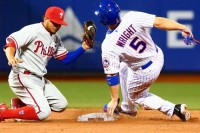
I’m not the first, and I’m not going to be the last to compare David Wright and Don Mattingly. My goal today is to hopefully be a little more nuanced than a side by side comparison. Rather, I want to see exactly how back problems deteriorated Mattingly’s abilities.
Normally, I would use Lenny Dykstra as a comparable because he also has spinal stenosis. However, I don’t know if I can trust any of his stats with his steroids usage. We do know like Wright, Mattingly suffered from a low back injury. The nature of the two injuries are different, but they are both chronic problems.
It appears the problems first surfaced in 1987. In that year, Mattingly went from a 7.2 WAR to a 5.1 WAR player. In essence, he went from a superstar to an All Star player. He would then quickly deteriorate into just a “good” player. Mattingly’s back worsened in 1990, and with that he became a -0.3 player, which translates to a bad player. For the rest of his career, Mattingly would be nothing more than a solid starter. He retired at the early age of 34.
Wright has had a terrific career, arguably better than Mattingly. In 2007 and 2008, Wright was a superstar player, as per WAR. In 2009, the Mets moved to Citi Field and Wright was nothing more than a solid starter. In 2010, Wright suffered a broken back. Unlike Mattingly, Wright would rebound from his back injury to put up superstar numbers again in 2012 and 2013.
Last year, Wright regressed again. However, last year it was a shoulder injury and not a back injury. This year it was discovered that Wright has spinal stenosis. We don’t know if it’s related to the 2010 injury.
What I do know is that Wright and Mattingly are two different players. We have seen that Wright once overcame a back injury, a different back injury, to return to superstar form. Mattingly never did. So yes, both are popular New York corner infielders. Both have back injuries.
However, they are two different players with two different back injuries. We shouldn’t be comparing them to determine how the rest of Wright’s career is going to proceed. Wright is a different player and person.
I’m nervous about Wright, but after 2012 and 2013, I won’t bet against him.
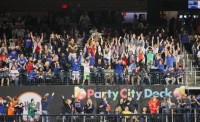
Diehard fans hate the wave. Casual fans love it. Remember Mets fans, if you want the Mets to take back New York, we’re going to have to deal with the casual fan.
Personally, the wave is annoying. I like to keep score, and I always have a soda. I have to drop everything to do the wave. With that said, the reason I participate is for little kids. Since the wave is annoying, but I see its merit, I think there should be some groundrules.
RULE 1: The Wave is Always Acceptable on Camp Days
You see, little kids love the wave. They watch for it to come. They clap and cheer for it to make it. When the wave reaches its destination, everyone cheers. When it doesn’t get there, everyone boos. You won’t admit this, but at times, even the wave can be fun.
Keep that in mind for those few 12:00 day games in the weekday in the summer. Those games are for the kids. If they want to do the wave, let them do it. The idea is to let kids have fun and want them to want to come back to more games. Let them have their wave.
By extension, also allow the wave on Family Sunday or any game with a kids giveaway. However, these two days, unlike the camp games, are subject to Rules 8 & 9.
Rule 2: If There is a Kid Near You at Least Fake It
If there’s a kid near you at any game, please give the minimal effort. It doesn’t hurt you to stay in your seat and throw your hands up. At least you won’t be the jerk who killed the wave and let a kid cry. A corollary to this is if you helped kill the wave, and there is an upset kid near you, you can’t complain about the kid. You helped create the situation.
Rule 3: You Are Never Obligated to Help Start a Wave
Personally, I do not think this conflicts with the second rule. There, I only ask for minimal effort. To start the wave, you actually have to stand up and get loud. You’re not disappointing a child because the wave didn’t exist yet. If a child is upset at that, their parent either needs to try to start one, or if they are trying themself, they need to do a better job.
Rule 4: You Only Get Three Chances to Start the Wave
When you do a wave, you’re irritating a lot of people. The most annoyed people are the ones in your section. They constantly hear some idiot screaming to the top of their lungs “1! 2! 3! Ahhhh!” If it fizzles, let it die. It was never meant to be.
My suggestion is if you really want to do the wave politely go around the section and try to spread the word BETWEEN INNINGS. Tell them you’re doing it for your kid. I’m sure most people would oblige. If you try that and the wave still isn’t going, move on. These people aren’t doing it. Don’t annoy them and waste your time. Just sit back and enjoy the game.
Rule 5: You Must Be Sober When You Start the Wave
First, you have to be coherent if you want people to listen to you. Two, you don’t want to be belligerent when people don’t acquiesce. Three, if you fail and if you’re annoying people, don’t give them an excuse to get security to remove you. If you’re a jerk trying to get a wave started, security may talk to you. If security hears you’re drunk and screaming, they’ll remove you from the game. Be smart here.
Rule 6: You Must Be in LF or RF to Start the Wave
This isn’t a Choose Your Own Adventure book. The wave must only head in one direction and one direction only.
Rule 7: There Must Be a Sellout
Lets face it you’re not going to sit in the far wings of the Upper a Deck by yourself if you are, there’s no way the wave gets started. You and five friends can all stand up and hoot and holler, but the people 10 sections over won’t hear you or care.
As a corollary to this rule, you need to start the wave in the Upper Deck. I know it’s the Primenade now, but it’ll always be the Upper a Deck to me. The reason for the corollary is the Field Level costs way too much, so they’re doing what they want. The other tiers are partially obstructed views and don’t have the same effect. Keep in mind if you do your job well enough, they may join in anyway.
Rule 8: No Waves in Close Games
We’re all there to have fun, but mostly we’re there to enjoy a baseball game. If there’s a close game, chances are it’s a good one. When you stand up, it should be to cheer; not do the wave.
By extension, the earlier in the game the better . . . like the first three innings. In fact, if done properly the wave can bring some energy into the stadium. Surprisingly, the wave then might actually be a benefit by getting the crowd pumped and building some electricity for the team to feed upon.
Rule 9: No Waves in October
Ultimately, you’re there to enjoy the games. Your time to bring your kids for fun was the Spring and Summer. That’s also the time for the casual fan. October (and really September) is for the die hards. If you bring your kid to the game (I know I will), explain there is a time and place, and this is not the time and place for booing.
The die hard Mets fan has been waiting for this day for 10 years now. They’ve been desperately waiting for a Workd Series for 30 years. They’re dying for this moment. The casual fan, who so happened to get a ticket,and wants to start a wave doesn’t get a right to ruin anything for the diehard fan.
Rule 10: If Someone Ignores These Rules, You May Boo Them
Someone won’t do the wave when kids are around, boo them. Someone won’t stop trying to set up the wave, boo them. Someone tries to do a wave in October, boo them until you crush their soul.
Keep in mind, I’m only advocating booing. Never resort to insults, profanity, or name calling. Like Rule 5, don’t give someone an excuse to get you removed from a game.
Overall, let’s make it a fun environment for everyone. I know I personally treat it like life and death, but it’s only a game. It’s supposed to be fun. The next time a way comes around just go with it. Maybe letting go a little will make you feel more relaxed and enjoy the game more.
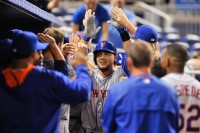
Last week, I wrote about how I thought with Michael Cuddyer coming off the DL, the Mets should’ve sent Michael Conforto down to AAA.
My belief was that a Kelly Johnson/Juan Lagares platoon would be more effective than Comforto is right now. However, with some intensive work in AAA and some adjustments, Conforto would be a terrific option in September and beyond. Overall, however, my conclusion is if Cuddyer’s healthy, he should play everyday.
I never framed my opinion as a referendum between Conforto and Eric Campbell. The first reason is my argument focused around letting Conforto play everyday. He’s not going to get better on the bench. Campbell isn’t keeping Conforto in the bench; Terry Collins is. I understand why people saw it this way because the choice was between sending down Conforto or Campbell.
My issue was what would benefit Conforto the most. I’ve had some interesting conversations since the post. I’ve found many have misstated Conforto’s stats and impact. I’ve found many who are alright with disregarding his development for the sake of 2015. Interestingly, I’ve found at least one Mets fan that believed Conforto being in New York was better for his development:
@MetsDaddy2013 @mikehiel If everyone else is going good, I would think Long would definitely have more time for young rook.
— Metstradamus (@Metstradamus) August 10, 2015
On Wednesday, I think we saw there was merit to the argument. Metstradamus made a superb point about Kevin Long, and it does seem Conforto is learning something. I mention Metstradamus here because he deserves due credit for giving an original, well thought out response as to why Conforto should stay in the majors.
However, I’ll be honest; I am still convinced I was right in calling for Conforto to be called down. I think two weeks in the minors would’ve done a great deal of good for Conforto and the Mets in September and October. Through all of this, I still maintain Conforto needs to be on the postseason roster.
The reason I think I’m still correct is Conforto barely played last week. Here is his past week:
8/11: DNP
8/12: 0-1 (PH appearance)
8/13: 2-3 with a walk and a double
8/14: 0-1 (PH appearance)
8/15: 1-4 with a homerun
8/16: DNP
8/17: off day
In a one week span, he only got 10 plate appearances, and two of those were PH opportunities. It looks like he will play Tuesday and Wednesday against the Orioles. They’re off on Thursday, and then they go to Colorado, who has three LHP in their rotation. It looks like next week could be more of the same.
Overall, I’m not shying away from my opinion even if there is a possibility I could be wrong. The funny thing is we may never know if I was wrong or right. I don’t care as much in being right as I am in Conforto’s development. He looks like a star, and I want him to be given every opportunity to become that star.
In the future, I invite everyone to debate me whether it be in the comments, on Twitter, or anywhere else. Thank you again for taking the time to read.
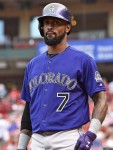
I can and have gone on and on ad nauseum about the Mets bringing back Jose Reyes. I promise this entry isn’t that.
Everyone concludes, including myself, that Reyes is not coming back. We know he didn’t want to leave. We know the Mets still haven’t found a SS. We know he hasn’t sold his home. Now, he’s playing in Colorado. I’m sure he misses his family, and we all know Colorado has excellent schools, right Mike Hampton?
This isn’t the move I’m referring to in the title. only joking. I would never pretend to tell someone else how to raise their family. Fatherhood is difficult enough while trying to raise someone else’s kids.
I’m not even referring to another team who may trade for him. Rather, I’m referring to Reyes making a move towards the Hall of Fame. I believe if he is going to make it, he’s probably going to need 3,000 hits.
Reyes’ 162 game average is 198 hits per season. Going into this year, he’s only averaged 120 games a year, and he’s averaged 148 hits per year. That may seem low, but he has missed time due to injuries. Entering this season, he had 1,772 hits. He now sits at 1,866. He’s currently 1,134 short of 3,000.
There are 47 games left in the Rockies season. If we assume Reyes will continue to play 74% of his team’s games, he has approximately 35 games left in the season. At a rate of 1.2 hits per game, he will get an additional 42 hits. This would leave him with about 1,908 hits or 1,092 short of 3,000.
If he continues to average 148 hits, he’ll need about eight more years to reach 3,000. That’s a lot to ask considering you’re asking him to play everyday into his age 42 season.
I know he wants to come back to New York, but maybe going to Colorado was a blessing in disguise. Now we know, players hit 17% better at Coors Field. I doubt the Rockies will pick up his $22 million option in 2018. That means, barring a trade, he will only have two full years in Coors Field.
As noted above, Reyes averages 148 hits per season. In his career, Reyes gets 51% of his base hits at home. That means in a typical season, Reyes can expect to get 75 hits at home and 73 on the road. If we apply the 17% Coors Field factor, Reyes average home hits would increase to 88 hits. This would increase his hits total from 148 to 161.
Accordingly, two years in Coors Field would put him at approximately 2,232 hits or 768 hits short entering his age 35 season. At 161 hits per year, he’d need approximately 5 more years to reach 3,000. If Reyes is healthier getting off the turf and plays 150 games per year, his hit totals could increase by an additional 40 hits per year, or 80 total. This would put him at 2,312 or 688 short.
Now when he’s a free agent, he will have to decide if: 1) he wants to make the push towards 3,000; 2) he wants to win; or 3) hopefully both.
If he goes for option #1 or #3, maybe he could be inducted in the Hall of Fame. Quite possibly, he would then be the Mets first position player from their farm system to do so. Maybe the Mets would then retire his number 7. I’d love to be there for both ceremonies.
It’s a long shot right now. If that’s going to change, Reyes needs to embrace playing in Coors Field and make his move.

As I’ve noted before, this is not a political blog. I have strong political opinions, but they won’t be presented here. However, this blog does touch upon baseball and fatherhood, so I decided it was important for me to address the reopening of the U.S. embassy in Cuba.
From a baseball perspective, there has already been much written about a potential pipeline of talent to the U.S. For various reasons, I’m not as intrigued by that possibility. Honestly, if Cuba ever allowed their baseball players to come to the U.S., I imagine it would follow the Japanese NPB system.
Here’s what I’m more interested in:
- Will Americans be eligible to play in the Cuban National League; and
- Will Cuban MLB players be eligible to play in the WBC?
American Eligibility to Play in Cuba
I’m interested in the first one because we have seen MLB players go to the NPB and be successful. The most notable was Cecil Fielder, who improved in the NPB, and became the first player to hit 50 homeruns in 13 years (back when that meant something).
Since that time, there have been other players like Ryan Vogelsong, who have salvaged their games, there haven’t been any with the impact of Fielder. Now, the NPB seems to be used for a different purpose for American players. Kevin Youkilis went there to play one last season before retiring, rather than risking being cut for non-performance by an MLB team. Tuffy Rhodes decided to make a career out of being an NPB star than return to the U.S.
Now, I don’t know if the Cuban Leagues are better than the NPB. In fact, I doubt they are. However, it would be good to have another option for MLB players to resurrect their careers.
WBC
I know American baseball fans are as interested in the WBC as I am. Admittedly, there are many flaws in the series (innings limits, when it’s played), but I enjoy it anyway.
Overall, the two teams that have really underachieved have been the U.S. and Cuba. With each defection, the Cuban team continues to worsen. Here are some of the Cuban MLB players not eligible to play for Cuba anymore:
- Jose Abreu
- Yoenis Cespedes
- Aroldis Chapman
- Yasmani Grandal
- Adeiny Hechavarria
- Jose Iglesias
- Leonys Martin
- Yasiel Puig
- Alexi Ramirez
These are some good to very good MLB players. These players would really strengthen the Cuban national team. I want the U.S.A. to win the WBC, but I want them to beat the best to show they are the best. I want this to be more akin to Olmpic hockey and basketball, not a collection of guys willing to play.
I think the addition of the Cuban MLB players would spark their team and the WBC. There is a Cuba-U.S.A. baseball rivalry at the amateur level. Maybe the addition of the Cuban MLB players will cause the best American players to show up . . . not just some of them.
Summation
Overall, I have no idea of the political and baseball impact on the U.S. Embassy reopening in Cuba. While I know there are people who support it and those who vehemently oppose it, I think we all agree we want what’s best for the Cuban families. To a lesser extent, I think we would all enjoy better baseball.
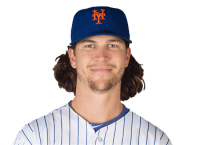
According to Carlos Gonzalez, Jacob deGrom is the best pitcher in baseball. This is notable because he shares a division with Clayton Kershaw, Zack Greinke, and Madison Bumgarner. With that said, I wanted to take a way too early look at deGrom’s chances of winning the Cy Young Award.
In doing this analysis. I wanted to take a look at different stats and predictors. I wanted to do this because I don’t think anyone one factor or stat should ever held to be dispositive. I went with the factors I fr most comfortable discussing. For each, I will only list the top five as that how many pitchers may be listed on a ballot.
ESPN Cy Young Predictor
The ESPN Cy Young Predictor focuses more on traditional stats like wins, losses, and ERA. As of right now, here are the rankings:
- Zack Greinke
- Trevor Rosenthal
- Michael Wacha
- Jacob deGrom
- Clayton Kershaw
WAR
WAR seeks to adjust the runs a pitcher allows in a season (I’m way oversimplifying, but fully explaining this is a post or 10 in and of itself). Here are the league leaders:
- Zack Greinke
- Max Scherzer
- Jacob deGrom
- Clayton Kershaw
- Jake Arrieta
FIP
Fielding Independent Pitching, or FIP, measures a pitcher’s effectiveness in preventing HR, BB, and HBP while causing strikeouts. Really, this measures the “Three True Outcomes.” Here are the league leaders:
- Clayton Kershaw
- Max Scherzer
- Zack Greinke
- Jacob deGrom
- Jake Arrieta
ERA+
ERA+ adjusts a pitcher’s ERA for various factors like ballpark and defense. Here are the league leaders:
- Zack Greinke
- Jacob deGrom
- Jake Arrieta
- Max Scherzer
- Clayton Kershaw
Winner
To calculate the winner, I’m using the BBWAA 7-4-3-2-1 formula to select the winner, i.e. first place gets seven points and fifth gets one.
- Zack Greinke (24 points)
- Jacob deGrom (13 points)
- Clayton Kershaw (11 points)
- Max Scherzer (10 points)
- Jake Arrieta (5 points)
- Trevor Rosenthal (4 points)
- Michael Wacha (3 points)
Analysis
Much of this seems to suggest what we already assume we know: Zack Greinke is going to win the Cy Young. It’s always great when the stats are in agreement.
I think it also shows we are right in assuming the top pitchers also include Jacob deGrom, Clayton Kershaw, and Max Scherzer. However, it was enlightening to see Jake Arrieta is having a tremendous year, and yet, he wasn’t an All Star.
Overall, deGrom is a strong second, but still second in projected voting. There is still a lot of season left, so there still might be a chance. Even if he doesn’t win, he’s still had a great year.
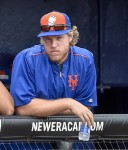
About three weeks ago, I addressed the Mets innings limitations problem. Without completely regurgitating everything here, my conclusion was that without a spot starter, Jacob deGrom would be the only stud muffin able to make a postseason start. Even at that, he would only be available for one game.
I thought with the latest go-round of stud muffin starts, it would be helpful to re-visit where we are on the innings limits:
Matt Harvey: I’ve noted his innings limits are between 180 – 190 innings. Right now, he’s at 148.0, or 42.0 innings before a hypothetical shutdown (don’t worry Collins said there’s no shutdown). By my rudimentary calculation, Harvey has nine starts left, at most. He’s averaging 6.2 innings per start meaning he will go over his limit by 18 innings (about three starts), not including the postseason.
Jacob deGrom: I’ve noted his innings limits are between 208 – 214 innings. Right now, he’s at 146.2, or 71.1 innings before needing to be shutdown. With approximately nine starts left and his averaging 6.2 innings per start, he looks to finish the year with 206.2 innings. It looks like he will be below his limits, postseason aside.
Noah Syndergaard: I’ve noted his innings limits are between 159.0 – 163.0 innings. Right now, he’s at 105.2, or 57.1 innings before needing to be shut down. With nine starts remaining and his averaging 6.2 innings per start, he looks to finish the year with 165.2 innings. He will be slightly above his innings limits right before the postseason.
So interestingly enough, if you’re only looking at the regular season, there isn’t an innings limitation problem with anyone but Harvey. This is yet again a sign the Mets shouldn’t “Matz” with the rotation right now.
While not addressing the pitching, Sandy Alderson did say, “[i]t’s about this year. Not next year.” I hope he keeps this in mind and puts Steven Matz in the bullpen. Remember it’s all about this year.
